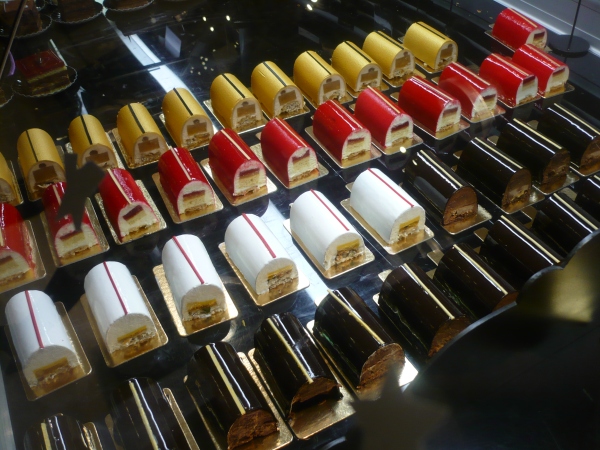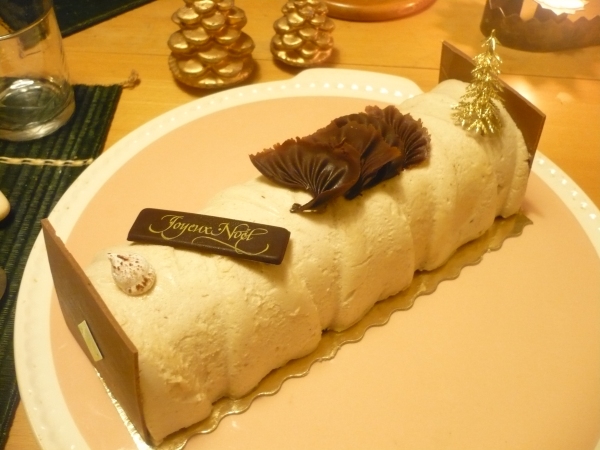Bûche de Noël: my French log
Visiting my family in Paris over Christmas, I knew I would eat bûche de Noël, the elaborate Yule log cake that French patissiers invented centuries ago and that has become the quintessential French Christmas pastry, iconic as the British plum pudding Dickens describes in A Christmas Carol. What I discovered, though, was a changing tradition, one that’s evolving in reaction to changing tastes. Today’s bûche de Noël is going light, airy, slick, modern.
The traditional bûche is made of genoise sponge cake spread with butter cream, rolled into a log shape, and then covered with more butter cream that is scored to look like the craggy bark of a tree. Decorated with tiny, cocoa-dusted mushrooms made of piped meringue and a light snowfall of powdered sugar, the bûche looks like something foraged from the forest. But all that butter cream makes it a rich end to a Christmas meal. This is, apparently, the current complaint—one which French patissiers are addressing by making lighter, mousse-based bûches.
I set out to investigate the bûche scene in Paris.
Already, I knew there had been a revolution in flavors. It’s taken me a while to get used to the idea. I grew up with bûches with traditional flavor profiles: chocolate, coffee, hazelnut nougatine, maybe raspberry. Last year, I wrote in half dismay when my Parisian family told me over the phone that they were eating a yuzu-flavored bûche de Noël. Yuzu?! What was the world coming to?! But why not? I no longer flinch when I see the pineapple or mango-passion-fruit bûche exotique. Not even raspberry-acai surprises me. The real revolution isn’t in flavors—but in texture and form. And evidence of this revolution was everywhere.
Certainly, you can still find traditional bûches de Noël. But even neighborhood patisseries’ displays reflect the changing times.
Here we have the classic exercises in holiday indulgence. There’s a line of classic log-like bûches in the center. On the bottom left, a chestnut bûche covered with thick squiggles of crème de marron, a rich, extremely sweet chestnut puree. Next to it, a chocolate bûche smothered in gaudy chocolate flowers (dusted with “snow,” of course). But the raspberry and vanilla bûches towards the back are from the new school of bûches. Their interior is airy mousse over a light biscuit (cake) base. The finishing touch is a glistening transparent glaze. Gone are the layers of genoise and buttercream. They’re not trying to look like something from a forest.
Outside the humblest neighborhood pastry-shop window, in fact, there’s not a log-like bûche to be found. The most elegant venues all offer the new, light, ethereal creations. Like these, from the pastry case at Le Bon Marche, the oldest and most elegant department store in Paris.
And then there are whimsical creations like the ones I saw in the window of a fancy, boutique-type patisserie in the Marais. (See also the top photo.)
They look like high-end landscape art: the shrubbery; the English garden, the Sahara . . . These represent a new art of bûche.
And there are other evolutions. I love the little bûchettes most patisseries have started making—miniature bûches that are just right for one or two people. Christmas isn’t necessarily celebrated en famille anymore, with eight or ten people crowding around the dessert platter. A bûchette has all the qualities of a bûche, and you don’t have to be eating it until New Years Day.
(The clementine segments and chocolate-covered coffee beans give a sense of the size scale.)
The Christmas-Eve bûche I ordered for my family from the patisserie around the corner was a blend of the old and the new. My own nostalgia required some traditional elements. And so the flavor was chestnut. But the snow-drifts were of chestnut mousse, not buttercream. With its fragments of marron glacé inside, it was heaven–light and decadent at the same time.
For more bûche-oggling, the Paris food blog Paris by Mouth has a round-up of the city’s most outrageous, artful 2011 bûches here.
They’re also easier to find in the US. You can order them from Whole Foods, Williams Sonoma, or Harry and David.








wish i had had even a morsel of any of them. they all look like heaven!
It was interesting to hear and SEE how the Christmas buche has evolved. It seems they have been given new life and become an inspired art form. Almost minimalistic. It’s also a little disconcerting to me because what could have been more unique and quirky, yet reassuring, than the traditional French buche with its miniature snow covered forest world. I remember them with tiny deer and elves. A fir tree. A mushroom. A little hatchet. I felt better seeing a few of those along side their sleak younger cousins in your beautiful photos. Jly